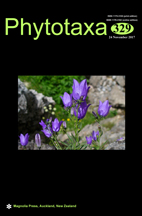Abstract
A new species of Pleroma from Serra dos Carajás, Pará state, Brazil, is described. Pleroma carajasense occurs in southeastern Amazonia, northern Brazil, in canga vegetation, on ironstone outcrops. It is morphologically related to Tibouchina caatingae, because both are shrubs with elliptic to oval leaves, conspicuous petioles (3–17 mm and 10–15 mm, respectively), a pair of elliptic bracteoles, and purple petals, anthers (both cycles) and style. Pleroma carajasense differs from T. caatingae by its chartaceous leaves (versus coriaceous in T. caatingae), with an obtuse to cuneate base (vs. obtuse to subcordate), hypanthium 4–7 × 1.2–4 mm (vs. 10–15 × 3–5 mm). According to IUCN criteria, this species should be considered endangered (EN). A morphological description, illustrations, photos in the field, scanning electronic micrographs of the leaf indumentum and seeds, information on conservation status and distribution are presented.

